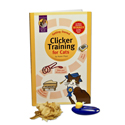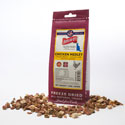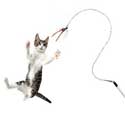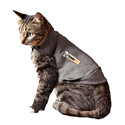When cats claw the furniture, declawing is not the answer. The process sounds innocuous but what really happens is that your cat is amputated the top joint of all ten phalanges on the front paws. It is exactly as if somebody did that to all ten of your fingers. It is excruciating, takes a long time to heal, and cats sometimes die of shock.
Scratching is more of a management issue than a training issue. The best coverage on the subject is by my friend Nick Dodman, head of the Tufts vet school Behavior Clinic, in his book, The Cat who Cried for Help. Cats claw the furniture (and walls) for the express purpose of leaving a mark. It is a cat's way of proclaiming ownership of its territory to other cats. They look for a location that is really conspicuous --like the corner of the couch facing the door. They look for something they can really sink their claws into and then shred, to leave a good mark (there are scent glands in the paws that probably add to the effect, for other cats).
The first management tool is to provide proper scratching posts in two or three conspicuous places. They need to be really sturdy, many of the commercial posts are far too wobbly. The cat wants to feel that its mark will remain! The material should shred somewhat--I've seen some good ones made of natural fiber rope, and my son's cat really goes for a flat panel of sort of nubby plastic, from PetCo, that she can, with effort, tear little bits off of. She has made quite a dent in it over the past year. Dodman makes some good suggestions for creating your own. I have often thought that some designer ought to come up with a behaviorally appropriate cat scratching post that is also a handsome object you won't mind having around, (instead of a hideous thing made of cardboard and beige carpeting) but if anyone has, I don't know about it.
You can click and treat the cat for using the new post. If you have multiple cats, it's ok to click and treat just one, the others will study it to see what it did to earn the treat. Or you can click the one that's scratching, and treat all of them—does no harm, just makes the click more powerful. Meanwhile, while the cats are getting used to the new post, you want to protect the furniture from use. There's a great new product called Sticky Paws, you can get it at PetCo. It's small transparent rectangles that are sticky on both sides. You stick it on the furniture where the cat scratches, and that spot ceases to be interesting to the cat.
My cat uses the living room rug to scratch on, and that's ok with me, it doesn't show and she doesn't really do any harm. But she also likes the foremost corner of my green wing chair, and that does pull threads; so I put two little Sticky paws there, and she has left it alone ever since. You can't see them, it's not noticeable if you sit in the chair (clothing doesn't stick to it) and I highly recommend it. You might find that you start with quite a few, during the transition period to the newer and better scratching posts, and then you can take them away after a while.
One family tells me they are having trouble with their three cats clawing their beautiful new woven silk wallpaper. That sounds like a really appealing target, a big area on which visible marks can so easily be made—I am not quite as sanguine about curing that particular problem. You could try Sticky Paws every few inches—maybe they come with suggestions for larger areas, I don't know—maybe supplying other scratching areas will help. Maybe you would have to cover the lower part of the wallpaper with plastic for a while; experiment and see.
Finally, as my cat book will tell you, giving the cats other things to do and think about, namely teaching them (or the worst offender, if there is one) some clicker tricks and games, often has the side effect of reducing unwanted behavior such as destruction projects. We don't know why yet, and there's no research, but the general feeling in the clicker community is that it gives the cat some novel experiences to think about and to look forward to, and these new interests cure the cat's boredom and replace the urge to wreck the house.








Attractive cat posts
http://www.angelicalcat.com/
I love these posts. Mine has lasted through 6 cats, looks almost as good as new, is so comfortable that my cats will go into uninteresting rooms to lie on it. It is equally accessible for declawed and clawed cats. My cats range in size from kittens to super-sized and it's great for all of them. They're a bit of an investment (though there's now an economy line) But a piece of furniture that can be clawed for 7 years and by multiple cats while still looking good is worth the extra, if you ask me.
Post new comment